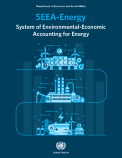SEEA-Energy
Energy statistics and accounts serve as tools to develop and strengthen energy information systems in countries. Energy statistics are often developed to address specific policy questions and issues, and energy accounts merge a wide range of energy related statistics across sectors into one consistent framework.
SEEA-Energy
SEEA-Energy is a multi-purpose conceptual framework for organizing energy-related statistics. It supports analysis of the role of energy within the economy, the state of energy inputs and various energy-related transactions of environmental interest. It is fully consistent with the SEEA Central Framework. Energy information is typically presented in physical terms, but the SEEA-Energy also applies monetary valuations to various stocks and flows, based on the SEEA accounting approach. Two main types of accounts capture relevant energy information in a systematic way:
- Flow accounts: In physical terms these accounts record physical flows of energy between the environment and the economy. Physical flows are recorded in joules to provide a common unit to aggregate across energy sources. Parallel monetary accounts then record the monetary flows associated with energy-related transactions for energy products.
- Asset accounts: These accounts measure the quantity of mineral and energy resources and changes in these resources over an accounting period. These accounts can be compiled in physical terms, which provide valuable information about energy resource availability. They can also be compiled in monetary terms to show the contribution and depletion to natural capital of energy resources.



